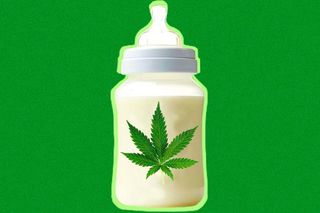
Pot Can Stay in Breast Milk Up to 6 Days After Mothers Smoke
The effect on babies is still unclear, but probably not good, researchers say.

A new study into pot use and breastfeeding has found that cannabinoids, that is, component substances of marijuana — including the psychotropic tetrahydrocannabinol (THC) — can linger in breast milk up to six days after mothers smoke up.
The research, published in Pediatrics, the official journal of the American Academy of Pediatrics, tested breast milk samples from 50 breastfeeding women who also reported on their method (inhalation, ingestion, or topical) and frequency of pot use. Most women (88%) in the study reported at least daily use of pot.
THC was detected in 63% of breast milk samples, while other cannabinoids were present in far fewer samples (9%). The concentration of these substances was directly proportional to the amount of time that had elapsed between when mothers expressed their samples and when they had last used pot. Overall, researchers estimate THC to have a half-life of roughly 27 hours; that is, 27 hours after last exposure, THC concentration in breast milk had reduced by half. But that’s a rough estimate — one sample of breast milk continued to contain THC up to six days after last instance of pot use.
The method of pot ingestion also appears to affect the concentration of cannabinoids in breast milk; the majority (76.5%) of women with measurable levels of THC in their breast milk reported that they only consumed marijuana via smoking up.
The effects on any baby consuming this breast milk is unclear. The study did not test babies’ blood for cannabinoid levels, but rather used statistical analysis to estimate what amount of pot substances babies might be consuming through breast milk. While they estimated the amount of THC babies receive via a single feeding to be 1000 times lower than the concentration in the body of an adult who had consumed a single dose (defined as 10mg of THC) of pot directly, they warn that this is not a definitive measure of children’s exposure. Given that most breastfeeding children feed multiple times a day, and THC is, in general, slowly eliminated from body fat stores, there is a risk of accumulation. The authors point to a previous case study in which an infant exposed to pot via breast milk had much higher concentrations of cannabinoids.
The effects of exposure, however, at any concentration in babies, is unknown. But the ages at which children typically breastfeed are times of rapid brain development, and the study authors point to previous research that suggests exposure to cannabinoids could have an effect on brain development, and manifest in cognitive or behavioral difficulties.
Ultimately, the findings highlight the need for more research in this area. Research has given breastfeeding women the information they need to manage their alcohol intake and still feed children without exposing them to alcohol via breast milk. While the finding that cannabinoids may linger up to six days in breast milk suggests that kind of simultaneous management may not be possible at all for using pot while breastfeeding, we won’t know for sure until researchers look more closely at cannabinoid concentrations in breast milk as they relate to the method, amount, frequency and time passed since mothers’ last consumption of pot, as well as direct measurements of breastfeeding infants’ cannabinoid concentration.
Related


Taking More Vacations Might Help You Live Longer
